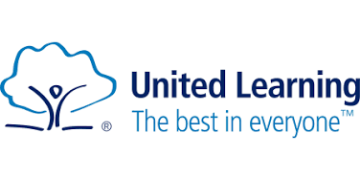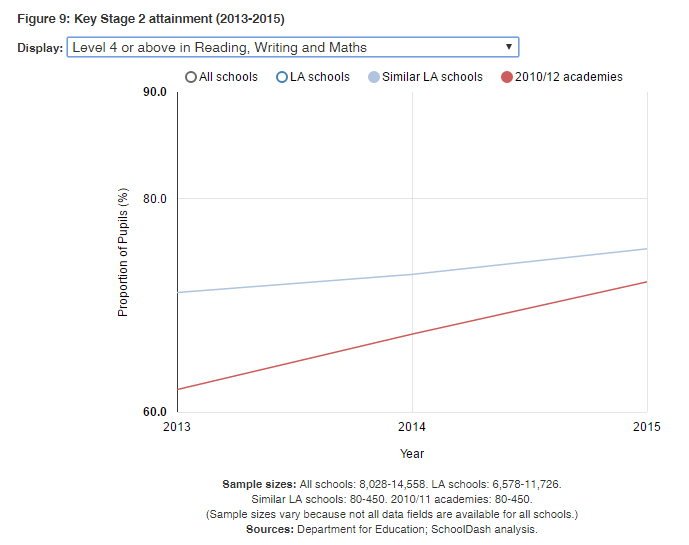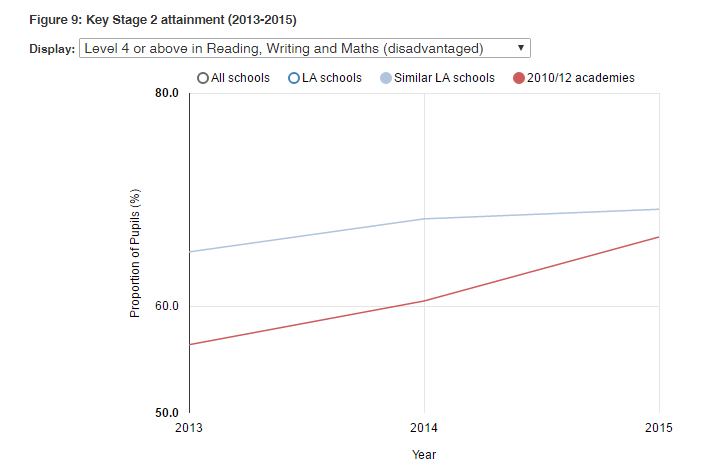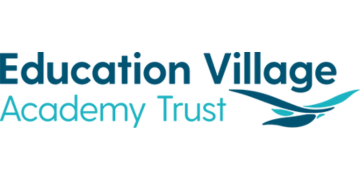Sponsor-led primary academies improve substantially after conversion, but there is no evidence that converter academies get any better, reveals new analysis from a schools data website.
Disadvantaged pupils at sponsor-led academies also improve more than their peers, show the SchoolDash findings, which are surprisingly similar to those for the secondary sector.
With less than 13% of primary schools having converted to academy status to date – compared to 65% of secondaries – the potential impact of the government’s academisation plan has been the topic of heated debate since Osborne’s announcement in March.
Now a new analysis of the Ofsted ratings, attainment and assessment results of existing primary academies gives some indication of the possible effects of conversion – although SchoolDash founder Timo Hannay was keen to point out that given the short timescale, “we’re almost certainly not seeing all of the change”.
Hannay said: “Our analysis of secondary sponsor-led academies suggested that improvements there took in the region of 4-7 years (perhaps even longer) to be fully realised and it’s quite possible that primary schools show similar timescales.”
TheSchoolDash analysis paired converter and sponsor-led academies with local authority (LA) maintained schools that had similar pupil profiles (socio-economic indicators, key stage 1 attainment and EAL), in order to achieve a fair comparison.
While it found minimal differences between academies and maintained primaries in most areas, there was a marked difference between the improvement of sponsor-led academies and similar LA schools over the two years of the study.
Sponsor-led academies are schools that have been compulsorily removed from local authority control in order to tackle historic underperformance.
Comparing the percentage of pupils achieving level 4 or above in reading, writing and maths between 2013 and 2015, sponsor-led academies managed to close the gap with similar LA schools by six percentage points. Sponsor-led academies increased their attainment rate from 62.1% to 72.2% over this period, while LA schools moved from 71.2% to 75.3% (see graph below).
This difference for disadvantaged pupils was particularly striking, with a 9.7 percentage point difference in 2013 (56.4% vs. 65.1%) being narrowed to a 2.6 point difference in 2015 (66.5% vs. 69.1%) (see graph below).
Hannay stressed that sponsor-led academies are still, on average, underperforming other schools, even those with similarly challenging intakes.
However, the report notes they do appear to have become “noticeably better in a relatively short time following academy conversion.”
It concludes: “This suggests a similar picture to the one we saw with secondary schools: when converted to academies, good schools generally stay good and bad schools generally get better.”
What the author said:
 Dr Timo Hannay, founder of SchoolDash, said: “The challenge for those who support compulsory academisation, is to explain why a good school should be forced to covert against its wishes if there are unlikely to be any tangible academic gains.
Dr Timo Hannay, founder of SchoolDash, said: “The challenge for those who support compulsory academisation, is to explain why a good school should be forced to covert against its wishes if there are unlikely to be any tangible academic gains.
“And the challenge for those who oppose it is to explain how else they would reduce the disparity between the best and the worst schools in the country, a gap that is still far too wide.”
The full report is available on the SchoolDash website.
The map above shows the relative density of converter primary academies.









Dr Hannay says the ‘challenge’ to those of us who oppose compulsory academisation is to explain how to improve struggling schools. The National Audit Office has already answered this question: it found informal intervention such as local support was more effective in improving schools than formal intervention such as academy conversion. And such informal intervention costs a great deal less than conversion. It also allows non-academies to retain their autonomy rather than be taken over by a multi-academy trust where the amount of ‘freedom’ is under the control of MAT trustees.
What does not appear to have been factored in is the additional resources that are made available to convertors to support their school improvement plans. It’s coming from central government pots separate from the funding available generally for schools. In contrast the funding to support maintained schools who need to improve comes from within the overall funding available for all schools in that area. So there is not a level playing field which allows a fair basis for comparison. There is also plenty of experience to show that some local authorities are much better than others at ensuring struggling schools improve. Why not harness the experience of those organisations to spread good practice rather than assuming that new ones will have the capacity to do so. The mantra of MAT good, LA bad is wearing increasingly thin.
I’m not sure I understand how a sponsor led academy that starts at 62.1% attainment is comparable with an LA school that starts with 71.2% attainment. I suspect improvement from a lower starting point might well be easier and faster. What was done to evaluate this I wonder?